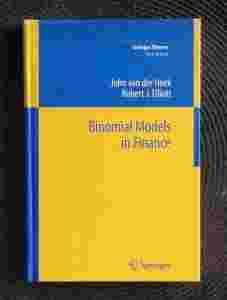
Polecamy książki dla fachowców w najtańszych cenach na Allegro
Pamiętaj zawsze możesz do nas zadzwonić
533 [zasłonięte] 038
/ w dni powszednie od 10 do 17 / lub napisać
[zasłonięte]@ksiegarnia-fachowa.pl
|
BINOMIAL MODELS IN FINANCE
JOHNVAN DER HOEK, ROBERT J. ELLIOTT
SPRINGER, 206 PAGES, HARDCOVER
|
|
This book deals with many topics in modern financial mathematics in a way that does not use advanced mathematical tools and shows how these models can be numerically implemented in a practical way. The book is aimed at undergraduate students, MBA students, and executives who wish to understand and apply financial models in the spreadsheet computing environment.
The basic building block is the one-step binomial model where a known price today can take one of two possible values at the next time. In this simple situation, risk neutral pricing can be defined and the model can be applied to price forward contracts, exchange rate contracts, and interest rate derivatives. The simple one-period framework can then be extended to multi-period models. The authors show how binomial tree models can be constructed for several applications to bring about valuations consistent with market prices. The book closes with a novel discussion of real options.
Contents:
1 Introduction
1.1 No Arbitrage and Its Consequences .
1.2 Exercises
2 The Binomial Model for Stock Options
2.1 The Basic Model .
2.2 Why Is ? Called a Risk Neutral Probability? .
2.3 More on Arbitrage
2.4 The Model of Cox-Ross-Rubinstein .
2.5 Call-Put Parity Formula
2.6 Non Arbitrage Inequalities
2.7 Exercises
3 The Binomial Model for Other Contracts
3.1 Forward Contracts
3.2 Contingent Premium Options
3.3 Exchange Rates
3.4 Interest Rate Derivatives .
3.5 Exercises .
4 Multiperiod Binomial Models .
4.1 The Labelling of the Nodes
4.2 The Labelling of the Processes
4.3 Generalized Quantities
X Contents
4.4 Generalized Backward Induction Pricing Formula .
4.5 Pricing European Style Contingent Claims .
4.6 The CRR Multiperiod Model
4.7 Jamshidian’s Forward Induction Formula .
4.8 Application to CRR Model
4.9 The CRR Option Pricing Formula
4.10 Discussion of the CRR Formula
4.11 Exercises .
5 Hedging
5.1 Hedging .
5.2 Exercises .
6 Forward and Futures Contracts .
6.1 The Forward Contract .
6.2 The Futures Contract .
6.3 Exercises .
7 American and Exotic Option Pricing
7.1 American Style Options .
7.2 Barrier Options
7.3 Examples of the Application of Barrier Options
7.4 Exercises
8 Path-Dependent Options
8.1 Notation for Non-Recombing Trees .
8.2 Asian Options .
8.3 Floating Strike Options
8.4 Lookback Options .
8.5 More on Average Rate Options .
8.6 Exercises
Contents XI
9 The Greeks
9.1 The Delta (?) of an Option
9.2 The Gamma (?) of an Option .
9.3 The Theta (?) of an Option .
9.4 The Vega (?) of an Option
9.5 The Rho (?) of an Option
9.6 Exercises .
10 Dividends .
10.1 Some Basic Results about Forwards
10.2 Dividends as Percentage of Spot Price
10.3 Binomial Trees with Known Dollar Dividends .
10.4 Exercises
11 Implied Volatility Trees
11.1 The Recursive Calculation
11.2 The Inputs V put and V call
11.3 A Simple Smile Example
11.4 In General .
11.5 The Barle and Cakici Approach .
11.6 Exercises
12 Implied Binomial Trees
12.1 The Inputs
12.2 Time T Risk-Neutral Probabilities .
12.3 Constructing the Binomial Tree
12.4 A Basic Theorem and Applications
12.5 Choosing Time T Data .
12.6 Some Proofs and Discussion
12.7 Jackwerth’s Extension .
12.8 Exercises
XII Contents
13 Interest Rate Models .
13.1 P(0, T) from Treasury Data .
13.2 P(0, T) from Bank Data .
13.3 The Ho and Lee Model
13.4 The Pedersen, Shiu and Thorlacius Model .
13.5 The Morgan and Neave Model
13.6 The Black, Derman and Toy Model
13.7 Defaultable Bonds
13.8 Exercises
14 Real Options .
14.1 Examples
14.2 Options on Non-Tradeable Assets .
14.3 Correlation with Tradeable Assets
14.4 Approximate Methods .
14.5 Exercises
A The Binomial Distribution
A.1 Bernoulli Random Variables .
A.2 Bernoulli Trials
A.3 Binomial Distribution
A.4 Central Limit Theorem (CLT) .
A.5 Berry-Ess´een Theorem
A.6 Complementary Binomials and Normals
A.7 CRR and the Black and Scholes Formula .
B An Application of Linear Programming .
B.1 Incomplete Markets .
B.2 Solutions to Incomplete Markets. .
B.3 The Duality Theorem of Linear Programming .
B.4 The First Fundamental Theorem of Finance .
B.5 The Duality Theorem .
B.6 The Second Fundamental Theorem of Finance .
B.7 Transaction Costs
Contents XIII
C Volatility Estimation
C.1 Historical Volatility Estimation .
C.2 Implied Volatility Estimation
C.3 Exercises .
D Existence of a Solution .
D.1 Farkas’ Lemma .
D.2 An Application to the Problem .
E Some Generalizations
E.1 Preliminary Observations .
E.2 Solution to System in van der Hoek’s Method
E.3 Exercises
F Yield Curves and Splines .
F.1 An Alternative representation of Function (F.1) .
F.2 Imposing Smoothness .
F.3 Unknown Coe.cients
F.4 Observations .
F.5 Determination of Unknown Coe.cients .
F.6 Forward Interest Rates
F.7 Yield Curve
F.8 Other Issues
References .
Index . |
|

